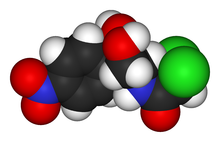Kloramfenikol
(Preusmjereno sa stranice Hloramfenikol)
Kloramfenikol je antimikrobni lijek, bakteriostatik, dobiven od bakterija iz roda streptomiceta (Streptomyces venezuelae) , a poslije se počeo proizvoditi sintetički. Djeluje tako da na ribosomima ometa sintezu bjelančevina. Kao i tetraciklin ima širok spektar djelovanja na aerobne i anaerobne bakterije. Njegova primjena je ograničena zbog sporadične teške toksičnosti na funkciju koštane srži, koja može prouzročiti smrtni ishod. Propisuje se samo za meningitis uzrokovan hemofilusom influence ili za trbušni tifus.

| |||

| |||
| Klinički podaci | |||
|---|---|---|---|
| Robne marke | Ak-chlor, Ak-Chlor Ophthalmic Ointment, Ak-Chlor Ophthalmic Solution, Alficetyn | ||
| AHFS/Drugs.com | Monografija | ||
| Identifikatori | |||
| CAS broj | 56-75-7 | ||
| ATC kod | D06AX02 , S03AA08 | ||
| PubChem[1][2] | 298 | ||
| DrugBank | DB00446 | ||
| ChemSpider[3] | 5744 | ||
| KEGG[4] | C00918 | ||
| ChEBI | CHEBI:17698 | ||
| ChEMBL[5] | CHEMBL130 | ||
| Hemijski podaci | |||
| Formula | C11H12Cl2N2O5 | ||
| Mol. masa | 323,129 | ||
| SMILES | eMolekuli & PubHem | ||
| |||
| Fizički podaci | |||
| Tačka topljenja | 150.5 °C (303 °F) | ||
| Farmakokinetički podaci | |||
| Poluvreme eliminacije | 1,5 - 3,5 h | ||
| Farmakoinformacioni podaci | |||
| Trudnoća | ? | ||
| Pravni status | |||
| Način primene | Oftalmički, intramaskularno | ||
Hloramfenikol je organsko jedinjenje, koje sadrži 11 atoma ugljenika i ima molekulsku masu od 323,129 Da.[6][7][8][9][10][11][12]
Osobine
uredi| Osobina | Vrednost |
|---|---|
| Broj akceptora vodonika | 5 |
| Broj donora vodonika | 3 |
| Broj rotacionih veza | 6 |
| Particioni koeficijent[13] (ALogP) | 1,0 |
| Rastvorljivost[14] (logS, log(mol/L)) | -4,1 |
| Polarna površina[15] (PSA, Å2) | 115,4 |
Reference
uredi- ↑ Li Q, Cheng T, Wang Y, Bryant SH (2010). „PubChem as a public resource for drug discovery.”. Drug Discov Today 15 (23-24): 1052-7. DOI:10.1016/j.drudis.2010.10.003. PMID 20970519.
- ↑ Evan E. Bolton, Yanli Wang, Paul A. Thiessen, Stephen H. Bryant (2008). „Chapter 12 PubChem: Integrated Platform of Small Molecules and Biological Activities”. Annual Reports in Computational Chemistry 4: 217-241. DOI:10.1016/S1574-1400(08)00012-1.
- ↑ Hettne KM, Williams AJ, van Mulligen EM, Kleinjans J, Tkachenko V, Kors JA. (2010). „Automatic vs. manual curation of a multi-source chemical dictionary: the impact on text mining”. J Cheminform 2 (1): 3. DOI:10.1186/1758-2946-2-3. PMID 20331846.
- ↑ Joanne Wixon, Douglas Kell (2000). „Website Review: The Kyoto Encyclopedia of Genes and Genomes — KEGG”. Yeast 17 (1): 48–55. DOI:10.1002/(SICI)1097-0061(200004)17:1<48::AID-YEA2>3.0.CO;2-H.
- ↑ Gaulton A, Bellis LJ, Bento AP, Chambers J, Davies M, Hersey A, Light Y, McGlinchey S, Michalovich D, Al-Lazikani B, Overington JP. (2012). „ChEMBL: a large-scale bioactivity database for drug discovery”. Nucleic Acids Res 40 (Database issue): D1100-7. DOI:10.1093/nar/gkr777. PMID 21948594.
- ↑ Bhutta ZA, Niazi SK, Suria A: Chloramphenicol clearance in typhoid fever: implications for therapy. Indian J Pediatr. 1992 Mar-Apr;59(2):213-9. PMID 1398851
- ↑ Wali SS, Macfarlane JT, Weir WR, Cleland PG, Ball PA, Hassan-King M, Whittle HC, Greenwood BM: Single injection treatment of meningococcal meningitis. 2. Long-acting chloramphenicol. Trans R Soc Trop Med Hyg. 1979;73(6):698-702. PMID 538813
- ↑ Puddicombe JB, Wali SS, Greenwood BM: A field trial of a single intramuscular injection of long-acting chloramphenicol in the treatment of meningococcal meningitis. Trans R Soc Trop Med Hyg. 1984;78 (3):399-403. PMID 6464136
- ↑ Pecoul B, Varaine F, Keita M, Soga G, Djibo A, Soula G, Abdou A, Etienne J, Rey M: Long-acting chloramphenicol versus intravenous ampicillin for treatment of bacterial meningitis. Lancet. 1991 Oct 5; 338(8771):862-6. PMID 1681224
- ↑ Nathan N, Borel T, Djibo A, Evans D, Djibo S, Corty JF, Guillerm M, Alberti KP, Pinoges L, Guerin PJ, Legros D: Ceftriaxone as effective as long-acting chloramphenicol in short-course treatment of meningococcal meningitis during epidemics: a randomised non-inferiority study. Lancet. 2005 Jul 23-29;366(9482):308-13. PMID 16039333
- ↑ Knox C, Law V, Jewison T, Liu P, Ly S, Frolkis A, Pon A, Banco K, Mak C, Neveu V, Djoumbou Y, Eisner R, Guo AC, Wishart DS (2011). „DrugBank 3.0: a comprehensive resource for omics research on drugs”. Nucleic Acids Res. 39 (Database issue): D1035-41. DOI:10.1093/nar/gkq1126. PMC 3013709. PMID 21059682.
- ↑ David S. Wishart, Craig Knox, An Chi Guo, Dean Cheng, Savita Shrivastava, Dan Tzur, Bijaya Gautam, and Murtaza Hassanali (2008). „DrugBank: a knowledgebase for drugs, drug actions and drug targets”. Nucleic Acids Res 36 (Database issue): D901-6. DOI:10.1093/nar/gkm958. PMC 2238889. PMID 18048412.
- ↑ Ghose, A.K., Viswanadhan V.N., and Wendoloski, J.J. (1998). „Prediction of Hydrophobic (Lipophilic) Properties of Small Organic Molecules Using Fragment Methods: An Analysis of AlogP and CLogP Methods”. J. Phys. Chem. A 102: 3762-3772. DOI:10.1021/jp980230o.
- ↑ Tetko IV, Tanchuk VY, Kasheva TN, Villa AE. (2001). „Estimation of Aqueous Solubility of Chemical Compounds Using E-State Indices”. Chem Inf. Comput. Sci. 41: 1488-1493. DOI:10.1021/ci000392t. PMID 11749573.
- ↑ Ertl P., Rohde B., Selzer P. (2000). „Fast calculation of molecular polar surface area as a sum of fragment based contributions and its application to the prediction of drug transport properties”. J. Med. Chem. 43: 3714-3717. DOI:10.1021/jm000942e. PMID 11020286.
Literatura
uredi- Hardman JG, Limbird LE, Gilman AG. (2001). Goodman & Gilman's The Pharmacological Basis of Therapeutics (10 izd.). New York: McGraw-Hill. DOI:10.1036/0071422803. ISBN 0-07-135469-7.
- Thomas L. Lemke, David A. Williams, ur. (2007). Foye's Principles of Medicinal Chemistry (6 izd.). Baltimore: Lippincott Willams & Wilkins. ISBN 0-7817-6879-9.